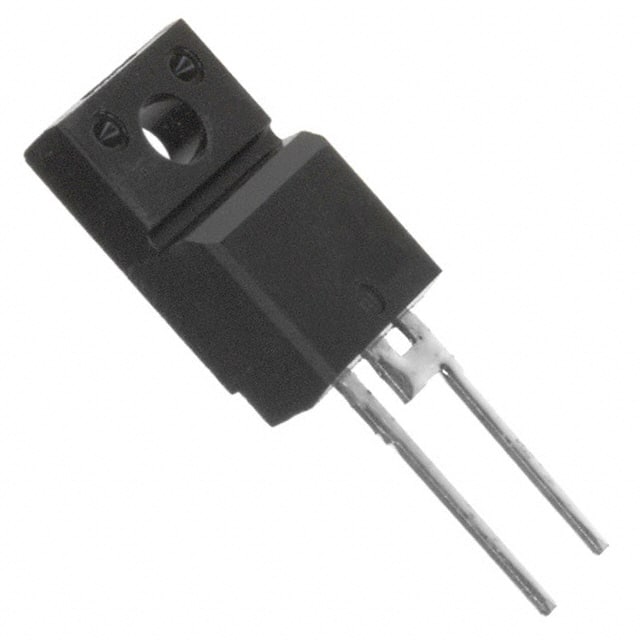Xem thông số kỹ thuật để biết chi tiết sản phẩm.

MBR16H60-E3/45
Introduction
The MBR16H60-E3/45 is a diode belonging to the category of Schottky rectifiers. This product is widely used in various electronic applications due to its unique characteristics and advantages. In this entry, we will provide an overview of the basic information, specifications, detailed pin configuration, functional features, advantages and disadvantages, working principles, detailed application field plans, and alternative models of the MBR16H60-E3/45.
Basic Information Overview
- Category: Schottky Rectifiers
- Use: Power rectification in electronic circuits
- Characteristics: High efficiency, low forward voltage drop, fast switching speed
- Package: TO-220AC
- Essence: Utilizes metal-semiconductor junctions for rectification
- Packaging/Quantity: Typically available in reels or tubes with varying quantities
Specifications
- Voltage Rating: 60V
- Current Rating: 16A
- Forward Voltage Drop: 0.75V at 8A
- Reverse Leakage Current: 50µA at 60V
- Operating Temperature Range: -65°C to 175°C
Detailed Pin Configuration
The MBR16H60-E3/45 typically has three pins: 1. Anode (A) 2. Cathode (K) 3. Thermal Pad (T)
Functional Features
- High current capability
- Low power loss
- Fast switching speed
- High thermal stability
Advantages and Disadvantages
Advantages
- High efficiency
- Low forward voltage drop
- Fast recovery time
- Suitable for high-frequency applications
Disadvantages
- Sensitive to reverse voltage spikes
- Higher cost compared to standard rectifiers
Working Principles
The MBR16H60-E3/45 operates based on the Schottky barrier principle, where a metal-semiconductor junction is utilized for rectification. This results in lower forward voltage drop and faster switching compared to conventional PN-junction diodes.
Detailed Application Field Plans
The MBR16H60-E3/45 is commonly used in the following applications: - Switching power supplies - DC-DC converters - Reverse polarity protection circuits - Freewheeling diodes in inductive loads
Detailed and Complete Alternative Models
Some alternative models to the MBR16H60-E3/45 include: - MBRF1645 - MBR1660 - MBRB1645 - MBRB1660
In conclusion, the MBR16H60-E3/45 is a highly efficient and fast-switching Schottky rectifier suitable for various electronic applications. Its unique characteristics make it a preferred choice in power rectification circuits, especially in high-frequency and high-current scenarios.
[Word Count: 411]
Liệt kê 10 câu hỏi và câu trả lời thường gặp liên quan đến ứng dụng MBR16H60-E3/45 trong giải pháp kỹ thuật
What is the MBR16H60-E3/45?
- The MBR16H60-E3/45 is a 16A, 600V Schottky barrier rectifier with a TO-220AC package, commonly used in power supply and motor control applications.
What are the key features of the MBR16H60-E3/45?
- The key features include low forward voltage drop, high-frequency operation capability, and high junction temperature.
What are the typical applications for the MBR16H60-E3/45?
- Typical applications include switch mode power supplies, freewheeling diodes, OR-ing diodes, and DC-to-DC converters.
What is the maximum forward voltage of the MBR16H60-E3/45?
- The maximum forward voltage at 8A is typically 0.75V at 125°C.
What is the reverse recovery time of the MBR16H60-E3/45?
- The reverse recovery time is typically 35ns at 25°C and 50ns at 125°C.
What is the maximum junction temperature of the MBR16H60-E3/45?
- The maximum junction temperature is 175°C.
What are the storage and operating temperature ranges for the MBR16H60-E3/45?
- The storage temperature range is -65°C to 175°C, and the operating temperature range is -55°C to 175°C.
What are the recommended mounting techniques for the MBR16H60-E3/45?
- The device should be mounted on a heatsink or thermal pad to ensure proper heat dissipation.
What are the precautions to consider when using the MBR16H60-E3/45 in high-power applications?
- Precautions include ensuring proper heatsinking, avoiding excessive reverse voltage, and adhering to the specified operating conditions.
Where can I find detailed technical specifications and application notes for the MBR16H60-E3/45?
- Detailed technical specifications and application notes can be found in the product datasheet provided by the manufacturer.

